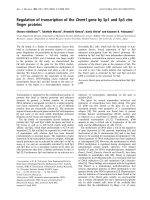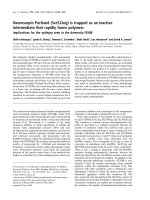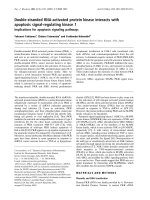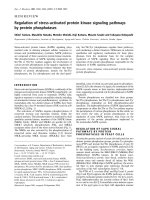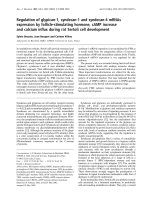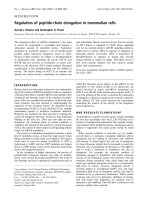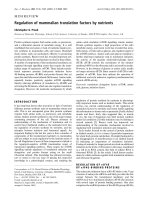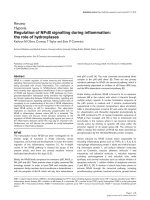Báo cáo y học: "Regulation of catabolic gene expression in normal and degenerate human intervertebral disc cells: implications for the pathogenesis of intervertebral disc degeneration" ppt
Bạn đang xem bản rút gọn của tài liệu. Xem và tải ngay bản đầy đủ của tài liệu tại đây (354.66 KB, 10 trang )
Open Access
Available online />Page 1 of 10
(page number not for citation purposes)
Vol 11 No 3
Research article
Regulation of catabolic gene expression in normal and
degenerate human intervertebral disc cells: implications for the
pathogenesis of intervertebral disc degeneration
S Jane Millward-Sadler, Patrick W Costello, Anthony J Freemont and Judith A Hoyland
Tissue Injury and Repair Group, School of Clinical and Laboratory Sciences, Faculty of Human and Medical Sciences, University of Manchester,
Stopford Building, Oxford Road, Manchester M13 9PT, UK
Corresponding author: Judith A Hoyland,
Received: 27 Nov 2008 Revisions requested: 20 Jan 2009 Revisions received: 8 Mar 2009 Accepted: 12 May 2009 Published: 12 May 2009
Arthritis Research & Therapy 2009, 11:R65 (doi:10.1186/ar2693)
This article is online at: />© 2009 Millward-Sadler et al.; licensee BioMed Central Ltd.
This is an open access article distributed under the terms of the Creative Commons Attribution License ( />),
which permits unrestricted use, distribution, and reproduction in any medium, provided the original work is properly cited.
Abstract
Introduction The aim of this study was to compare the effects
of tumour necrosis factor-alpha (TNF-α) and interleukin-1-beta
(IL-1β) on protease and catabolic cytokine and receptor gene
expression in normal and degenerate human nucleus pulposus
cells in alginate culture.
Methods Cells isolated from normal and degenerate nucleus
pulposus regions of human intervertebral discs were cultured in
alginate pellets and stimulated by the addition of 10 ng/mL TNF-
α or IL-1β for 48 hours prior to RNA extraction. Quantitative real-
time polymerase chain reaction was used to assess the effect of
TNF-α or IL-β stimulation on the expression of matrix
metalloproteinase (MMP)-3, -9 and -13, TNF-α, TNF receptor 1
(TNF-R1), TNF receptor 2 (TNF-R2), IL-1α, IL-1β, IL-1 receptor
1 (IL-1R1) and IL-1 receptor antagonist (IL-1Ra).
Results MMP-3 and MMP-9 gene expressions were
upregulated to a greater level by IL-1β than TNF-α. MMP-13
was upregulated by each cytokine to a similar extent. TNF-
α
and
TNF-R2 expressions were upregulated by both TNF-α and IL-β,
whereas TNF-R1 expression was not significantly affected by
either cytokine. IL-1
β
and IL-1Ra expressions were significantly
upregulated by TNF-α, whereas IL-1
α
and IL-1R1 were
unchanged.
Conclusions TNF-α does not induce MMP expression to the
same degree as stimulation by IL-1β, but it does act to
upregulate IL-1
β
expression as well as TNF-
α
and TNF-R2. The
net result of this would be an increased inflammatory
environment and accelerated degradation of the matrix. These
results support the hypothesis that, while TNF-α may be an
important initiating factor in matrix degeneration, IL-1β plays a
greater role in established pathological degradation.
Introduction
Disc degeneration is a major economic and social burden that
affects large numbers of people. It is a major cause of back
pain, which is one of the commonest causes of morbidity in the
West. Within the UK, approximately 11 million people experi-
ence lower back pain for at least one week out of every month,
and it is estimated to cost approximately £11 billion in lost pro-
duction due to absence from work [1]. Despite this, the patho-
genesis of degeneration is a complex process that is poorly
understood.
The intervertebral disc (IVD) is a fibrocartilaginous tissue situ-
ated between the vertebrae of the spine. It provides stability
and flexibility to the spinal column, allowing movement in all
directions. The IVD is composed of a central gelatinous
nucleus pulposus (NP), which provides the compressibility of
the tissue, and a surrounding fibrous annulus fibrosus (AF).
The NP is composed predominantly of the proteoglycan
aggrecan and type II collagen and is highly hydrated, whereas
the AF is made up of concentric lamellae of highly organised
type I collagen fibres that provide the tensile strength and
restrain the inner NP region. Molecular changes in degenera-
tion include altered matrix synthesis, including a decrease in
glycosaminoglycan production and an increase in collagen
type I within the NP, and upregulation of matrix-degrading
enzymes [2-5]. This results in an increase in matrix destruction,
ADAM-TS: a disintegrin and metalloproteinase with thrombospondin motif; AF: annulus fibrosus; GAPDH: glyceraldehyde-3-phosphate dehydroge-
nase; IL: interleukin; IL-1R: interleukin-1 receptor; IL-1Ra: interleukin-1 receptor antagonist; IVD: intervertebral disc; MMP: matrix metalloproteinase;
NP: nucleus pulposus; PCR: polymerase chain reaction; TNF: tumour necrosis factor; TNF-R: tumour necrosis factor receptor.
Arthritis Research & Therapy Vol 11 No 3 Millward-Sadler et al.
Page 2 of 10
(page number not for citation purposes)
decrease in tissue hydration, increase in fissure formation and
loss of disc height. These catabolic processes are thought to
be mediated by soluble factors such as the pro-inflammatory
cytokines interleukin-1-beta (IL-1β) and tumour necrosis fac-
tor-alpha (TNF-α) [6-9]. Histological studies by Bachmeier
and colleagues [10,11] have shown TNF-α and its receptors
to be expressed in normal IVD and upregulated with age and
degeneration. Seguin and colleagues [12] have demonstrated
in bovine cultures that TNF-α decreases expression of aggre-
can and type II collagen genes and upregulates mRNA expres-
sion of matrix metalloproteinase (MMP)-1, -3 and -13 and
ADAM-TS4 (a disintegrin and metalloproteinase with throm-
bospondin motif 4) and ADAM-TS5, resulting in a net cata-
bolic response. Previous studies from this laboratory have
investigated the expression of IL-1β and associated receptors
in disc degeneration and shown that IL-1α, IL-1β, IL-1 receptor
1 (IL-1R1) and IL-1 receptor antagonist (IL-1Ra) are
expressed by normal disc cells, with an upregulation of IL-1α,
IL-1β and IL-1R1, but not the IL-1Ra, during degeneration [7].
Furthermore, we have shown that, while both IL-1 and TNF are
expressed in IVD and upregulated with degeneration, degen-
erate IVDs show a much greater expression level of IL-1β than
TNF-α and that, while the IL-1R1 was upregulated in degener-
ation, the TNF receptor 1 (TNF-R1) was not [8,13,14]. How-
ever, there have been few studies comparing the effects of IL-
1β and TNF-α in adult human tissue or cells. A recent study
from our laboratory investigated the effect of IL-1β or TNF-α or
their antagonists on matrix-degrading activity from normal or
degenerate cells as determined by in situ zymography [14].
The results indicated that in all cases the basal degradative
activity of degenerate cells was greater than for normal cells
and that this was not significantly affected by treatment with
either exogenous IL-1β or TNF-α. However, the matrix-degrad-
ing activity in normal tissue was significantly upregulated by
the addition of IL-1β, but not TNF-α. Furthermore, enzyme
activity was inhibited in both normal and degenerate samples
by the addition of IL-1Ra but unaffected by the application of
anti-TNF-α. These results suggest that IL-1β, rather than TNF-
α, may be more important in the regulation of matrix-degrading
enzymes in IVD tissue, although the presence of TNF-α and
TNF receptors suggests that this cytokine may have a role to
play in IVD matrix regulation. Both cytokines have been shown
to upregulate catabolic processes in articular cartilage and the
IVD that lead directly to matrix degradation, and both TNF-α
and IL-1β are thought to be pivotal to the cartilage destruction
in arthritis [15,16]. This study compares the effect of TNF-α
and IL-1β on catabolic gene expression that leads to matrix
regulation and degradation in normal and degenerate NP cells
isolated from human adult tissue and investigates how TNF-
α
and IL-1β may be involved in regulation of themselves and
each other and their respective receptors.
Materials and methods
Tissue source
All human tissue was obtained in accordance with the Decla-
ration of Helsinki, and ethical approval for these studies was
obtained from the Trent Multi-centre Research Ethics Commit-
tee (reference 05/MRE04/3). Human IVD samples were
obtained either from post-mortem samples or from surgery
with the informed consent of patients or relatives. All samples
were assessed histologically and graded for degeneration
according to the method of Sive and colleagues [17]. Samples
from three normal discs (histological grades 1 and 2; mean
age 48 years, range 37 to 61 years) and three degenerate
discs (histological grades 7, 9 and 10; mean age 58.3 years,
range 35 to 79 years) were used for this study.
Cell culture
Cells were isolated from the central NP region of the IVD by
enzymatic digestion [7]; samples from each patient and from
normal and degenerate discs were processed separately.
Cells were cultured in standard medium – Dulbecco's modi-
fied Eagle's medium with glucose 4.5 g/L, GlutaMAX™ and
pyruvate (Gibco, now part of Invitrogen Corporation, Paisley,
UK) containing 50 μg/mL ascorbic acid, 250 ng/mL ampho-
tericin, 100 U/mL penicillin and 100 μg/mL streptomycin (Inv-
itrogen Corporation) and 10% (vol/vol) foetal calf serum
(Invitrogen Corporation) – and expanded in monolayer. Cul-
ture media were changed every 3 days. Cells were grown in
monolayer until they reached 70% to 80% confluence before
passaging to expand cell numbers. Passage number was kept
to a minimum as high numbers of passages have been
reported to influence cell response. A passage number
greater than 6 was shown to have a marked effect on disc cell
behaviour (J.A. Hoyland, unpublished data); therefore, all cell
samples were used at passage 4 or less.
Culture of disc cells in alginate beads
Cells were re-suspended at a density of 4 × 10
6
cells/mL
(equivalent to the cell density in the disc in vivo [18].) in 1.2%
(wt/vol) low-viscosity sodium alginate in 0.15 M NaCl and cul-
tured for 2 weeks prior to cytokine treatment to allow the cells
to regain their native phenotype. We and others have previ-
ously shown that IVD cells expanded in monolayer will re-dif-
ferentiate back to an in vivo phenotype if cultured in alginate
beads [7,19]. Culture media were changed every 3 days. Fol-
lowing cytokine treatment, cells were recovered from alginate
beads using dissolving buffer (55 mM sodium citrate, 30 mM
EDTA [ethylenediaminetetraacetic acid], 0.15 M NaCl, pH
6.0) and then pelleted by centrifugation before RNA extrac-
tion.
Treatment of disc cells with interleukin-1-beta or tumour
necrosis factor-alpha
Standard culture media were replaced with 2 mL of media
containing 10 ng/mL of either human recombinant IL-1β (AMS
Biotechnology Ltd, Abingdon, UK) or human recombinant
Available online />Page 3 of 10
(page number not for citation purposes)
TNF-α (AMS Biotechnology Ltd). Cells were stimulated for 48
hours and maintained at 37°C in a humidified atmosphere con-
taining 5% CO
2
. All treatments were carried out in triplicate.
This protocol has previously been shown to be sufficient for IL-
1β to significantly upregulate gene expression of MMP-3 and
-13 and ADAM-TS4 [7] and for TNF-α to significantly upregu-
late several of the ADAM-TS family (A. Pockert, J.A. Hoyland,
unpublished data).
RNA extraction
Samples for RNA extraction were pelleted by centrifugation
and the RNA was extracted using TRIzol™ and PureLink col-
umns in accordance with the instructions of the manufacturer
(Invitrogen Corporation). To prevent any DNA contamination
of the RNA, the samples were treated with DNAse I solution
(Qiagen Ltd., Crawley, UK), and RNA quality and quantity were
determined using the Nanodrop
®
ND-1000 Spectrophotome-
ter (NanoDrop Technologies, Inc., now part of Thermo Fisher
Scientific Inc., Waltham, MA, USA). cDNA was synthesised
from 500 ng of RNA using Superscript™ II Reverse Tran-
scriptase (Invitrogen Corporation) and random primers in
accordance with the instructions of the manufacturer cDNA
was stored at -20°C until required.
Quantitative real-time polymerase chain reaction
Real-time primers and probes for GAPDH (glyceraldehyde-3-
phosphate dehydrogenase), TNF-
α
, TNF-R1, IL-1
α
, IL-1
β
, IL-
1R1, IL-1Ra, MMP-3, -9, -13, aggrecan, collagen types I and
II and SOX9 were designed for TaqMan polymerase chain
reaction (PCR) using Primer Express software (Applied Bio-
systems, Warrington, UK) based on the genomic sequences
supplied in the GenBank database. Specificity for the primers
and probes was confirmed by BLAST (Basic Local Alignment
Search Tool) analysis. Primers and probe for TNF receptor 2
(TNF-R2) were purchased from Applied Biosystems as a pre-
Table 1
Sequences of primers and probes used in quantitative real-time polymerase chain reaction analysis
Target Forward primer Reverse primer Probe Accession number
GAPDH GCTGAACGGGAAGCTC
ACT
AGGTCAGGTCCACCACT
GA
CCCCACTGCCAACGTG [GenBank: NM_002046]
Aggrecan CCGTGTGTCCAAGGAGA
AGG
GGGTAGTTGGGCAGTG
AGAC
CTGATAGGCACTGTTGA
C
[GenBank: NM_001135
]
Collagen type I AGAACAGCGTGGCCTA
CATG
GCGCGGATCTCGATCTC
G
CAGCAGACTGGCAAC [GenBank: NM_000088
]
Collagen type II ATGGAGACTGGCGAGA
CTTG
GCTGCTCCACCAGTTCT
TCTT
CCCAATCCAGCAAACG [GenBank: NM_001844
]
SOX9 GACTTCCGCGACGTGG
AC
GTTGGGCGGCAGGTAC
TG
CGACGTCATCTCCAACA
T
[GenBank: NM_000346
]
IL-1α AAGAGGGAAGTTTGCTT
GATTAAGG
GAGGATCAAGACTTCTTT
GTGCTC
ACCACTGTTCTCTTCTCT
ACCCTGCCC
[GenBank: NM_000575
]
IL-1β CGGCCACATTTGGTTCT
AAGA
AGGGAAGCGGTTGCTCA
TC
ACCCTCTGTCATTCG [GenBank: NM_000576
]
IL-1 receptor I ATTTCTGGCTTCTAGTCT
GGT
AACGTGCCAGTGTGGAG
TGA
ACTTGATTTCAGGTCAAT
AACGGTCCCC
[GenBank: NM_000877
]
IL-1 receptor antagonist CCTGCAGGGCCAAGCA GCACCCAACATATACAG
CATTCA
AGCCTCGCTCTTGGCAG
GTACTCAGT
[GenBank: NM_173841
]
TNF-α CGAACATCCAACCTTCC
CAAAC
TGGTGGTCTTGTTGCTTA
AAGTTC
CCAATCCCTTTATTACCC [GenBank: NM_000594
]
TNF receptor 1 AATTCTGGCTTCTAGTCT
GGT
AACGTGCCAGTGTGGAG
TGA
TTCAGTCCCACTCCAGG
CTTCACCC
[GenBank: NM_001065
]
TNF receptor 2 PDAR PDAR PDAR
MMP-3 TGAAGAGTCTTCCAATC
CTACTGTTG
CTAGATATTTCTGAACAA
GGTTCATGC
TTTGCTCAGCCTATCCAT [GenBank: NM_002422
]
MMP-9 CCCGGAGTGAGTTGAAC
CA
CAGGACGGGAGCCCTA
GTC
TACGTGACCTATGACATC [GenBank: NM_004994
]
MMP-13 CCCCAGGCATCACCATT
CAAG
GACAAATCATCTTCATCA
CCACCAC
CTGCCTTCCTCTTC [GenBank: NM_002427
]
GAPDH, glyceraldehyde-3-phosphate dehydrogenase; IL-1, interleukin-1; MMP, matrix metalloproteinase; PDAR, pre-designed assay; TNF,
tumour necrosis factor.
Arthritis Research & Therapy Vol 11 No 3 Millward-Sadler et al.
Page 4 of 10
(page number not for citation purposes)
designed assay (PDAR). Sequences for primers and probes
are presented in Table 1.
All PCRs were set up in triplicate using a final volume of 25 μL
(2.5 μL cDNA) and Universal Taq mastermix (Applied Biosys-
tems). All primers were used at 900 nM, and probes were
used at 250 nM. Reactions were carried out and analysed by
an ABI Prism 7700 Detection System.
Initial analysis was performed using the 7000 System
Sequence Detection Software package (Applied Biosystems)
as a relative quantification study using GAPDH as the endog-
enous control gene and using the automatic settings to set
baseline and threshold values. The data were then exported
into Excel (Microsoft Corporation, Redmond, WA, USA) for
further analysis. Data were analysed using the 2
-ΔΔCt
method
using the housekeeping gene GAPDH and untreated controls
for normalisation [7].
Statistics
All samples were tested for normality using the Shapiro-Wilk
test. As all data were non-parametric, they were then analysed
by the Mann-Whitney U test.
Results
Effect of cytokines on matrix-degrading enzymes
There was no difference in the basal levels of gene expression
for MMP-3, -9 or -13 between untreated normal and degener-
ate NP cells (data not shown).
Tumour necrosis factor-alpha
The addition of recombinant TNF-α for 48 hours resulted in a
significant upregulation of MMP-3 mRNA in both normal and
degenerate NP cells (P = 0.05) and MMP-13 gene expression
in normal cells (P = 0.05) (Figure 1a). There was no significant
change in gene expression for MMP-9 in normal or degenerate
cells or for MMP-13 in degenerate cells (Figure 1a).
Interleukin-1-beta
The addition of recombinant IL-1β for 48 hours resulted in a
significant upregulation of mRNA of MMP-3, -9 and -13 in
both normal and degenerate NP cells (P = 0.05) (Figure 1b).
The upregulation of MMP-9 gene expression was significantly
greater in degenerate cells compared with normal NP cells (P
= 0.05), and the upregulation of MMP-13 was significantly
greater in normal than degenerate cells (P = 0.05). There was
no significant difference between the upregulation of MMP-3
in normal and degenerate NP samples.
The upregulation of MMP-3 mRNA was significantly greater by
recombinant IL-1β than TNF-α in both normal and degenerate
cells (normal: 7,695-fold and 420-fold, respectively; degener-
ate: 2,663-fold and 315-fold, respectively; P = 0.05). IL-1β
had a significantly greater effect than TNF-α on MMP-9 gene
upregulation in degenerate NP cells (23.5-fold and 7.6-fold,
respectively; P = 0.05), although the difference between IL-
1β-associated MMP-9 upregulation and TNF-α-stimulated
MMP-9 gene upregulation in normal NP cells was not signifi-
cant. There was no significant difference between the effect of
IL-β and TNF-α on MMP-13 gene upregulation in normal and
degenerate NP cells.
Effect of tumour necrosis factor-alpha on matrix gene
expression
The basal gene expression for the collagen type I gene was
significantly higher in the degenerate cells than in the normal
NP cells (P = 0.05). There was no significant difference in the
basal gene expression levels between normal and degenerate
cells for any of the other matrix genes examined (data not
shown).
The addition of recombinant TNF-α for 48 hours significantly
downregulated collagen type I gene expression in both normal
and degenerate NP samples (Figure 2), with the downregula-
tion in degenerate samples being significantly greater than for
normal samples (P = 0.05). Type II collagen mRNA was sig-
nificantly downregulated in normal NP cells following the addi-
tion of TNF-α (P = 0.05), but expression was not significantly
changed in degenerate cells (Figure 2). There was no signifi-
cant change in the gene expression of aggrecan or SOX9 in
either normal or degenerate NP cells following TNF-α stimula-
tion (Figure 2).
Effect of inflammatory cytokines on expression of
tumour necrosis factor-alpha and tumour necrosis factor
receptors
There was no difference in the basal expression levels of the
inflammatory cytokine genes or their receptors in normal and
degenerate untreated NP cells (data not shown).
Tumour necrosis factor-alpha
The addition of recombinant TNF-α for 48 hours resulted in a
significant upregulation of TNF-
α
and TNF-R2 genes in both
normal and degenerate NP cells (Figure 3a). TNF-R1 mRNA
was upregulated by TNF-α in normal NP cells but downregu-
lated in degenerate samples (Figure 3a). Neither of these
changes in mRNA expression was statistically significant,
although the difference between the upregulation in normal
cells and the downregulation in degenerate cells did reach sig-
nificance (P = 0.05). TNF-R2 mRNA was upregulated to a
greater extent in normal than in degenerate samples (P =
0.05).
Interleukin-1-beta
The addition of exogenous IL-1β for 48 hours resulted in a sta-
tistically significant upregulation of TNF-
α
and TNF-R2 genes
in both normal and degenerate samples (P = 0.05) (Figure
3b). The upregulation of TNF-
α
mRNA was significantly
greater in normal NP cells than degenerate samples (P =
0.05), whereas the TNF-R2 gene was upregulated to a greater
Available online />Page 5 of 10
(page number not for citation purposes)
extent in degenerate cells than normal NP samples (P = 0.05).
TNF-R1 gene expression was not significantly affected by the
addition of IL-1β in either normal or degenerate samples.
Effect of tumour necrosis factor-alpha on expression of
interleukin-1 and interleukin-1 receptors
The addition of recombinant TNF-α for 48 hours resulted in a
significant upregulation of IL-1
β
and IL-1Ra genes in both nor-
mal and degenerate NP samples (P = 0.05) (Figure 4). There
was no significant difference between the degree of upregula-
tion of either IL-1
β
or IL-1Ra genes in normal and degenerate
cells. IL-1
α
and IL-1R1 gene expressions were not signifi-
cantly altered in either normal or degenerate NP cells by the
action of TNF-α.
Discussion
This study investigates the effect of the pro-inflammatory
cytokines IL-1β and TNF-α on catabolic gene expression in
normal and degenerate IVD cells. Previous studies from our
laboratory have shown that, in the human, MMP-1, -3, -7 and -
13 are upregulated with increasing degeneration [2,7] and
that stimulation of cells in culture with IL-1β results in an
upregulation of MMP-3 and -13 as well as ADAM-TS4 and a
downregulation of aggrecan and collagen types I and II [7]. In
this study, we have expanded the investigation to include the
effect of TNF-α on matrix and MMP gene expression in normal
and degenerate NP cells as well as the effect of IL-1β and
TNF-α on cytokine gene expression and the expression of the
associated receptors and endogenous antagonists. There
Figure 1
Effect of cytokine stimulation on matrix metalloproteinase (MMP) gene expression in normal or degenerate nucleus pulposus (NP) cellsEffect of cytokine stimulation on matrix metalloproteinase (MMP) gene expression in normal or degenerate nucleus pulposus (NP) cells. Normal or
degenerate NP cells were cultured in alginate pellets and stimulated by the addition of 10 ng/mL tumour necrosis factor-alpha (TNF-α) (a) or inter-
leukin-1-beta (IL-1β) (b). Quantitative real-time polymerase chain reaction was used to analyse the effect of cytokine stimulation on gene expressions
of MMP-3, -9 and -13. All samples are relative to the housekeeping gene GAPDH (glyceraldehyde-3-phosphate dehydrogenase) and normalised
back to untreated controls. Results are given as mean ± standard error of the mean (n = 3). *P ≤ 0.05 when compared with untreated controls.
Arthritis Research & Therapy Vol 11 No 3 Millward-Sadler et al.
Page 6 of 10
(page number not for citation purposes)
was no difference in the basal levels for expression of each of
the genes studied between normal and degenerate untreated
cells, with the exception of type I collagen; thus, any changes
identified were due to the stimulatory or inhibitory effect of the
recombinant cytokines added to the cultures rather than any
difference in the initial levels. For type I collagen, there was a
higher basal level in degenerate cells when compared with
normal NP cells. This is consistent with the changes identified
in the degeneration of the IVD, which include an upregulation
in type I collagen protein in the NP region [20].
The results of this study show that TNF-α downregulates the
matrix genes collagen types I and II and aggrecan. This is con-
sistent with studies on bovine tissue which have shown that
TNF-α downregulates aggrecan and collagen type II [12] and
previous studies from our laboratory which have shown that IL-
1β significantly downregulates collagen types I and II and
aggrecan [7]. TNF-α had no effect on the matrix-associated
transcription factor SOX9, a finding that is consistent with pre-
vious findings from our laboratory which found that IL-1β did
not significantly affect SOX9 gene expression, although SOX6
was significantly decreased by IL-1β stimulation [7].
MMPs can be largely grouped in three classes by the sub-
strates they degrade: collagenases (including MMP-1 and -
13) that break down fibrillar collagens, gelatinases (MMP-2
and -9) that act on denatured collagens and collagen types IV
and V, and stromelysins (including MMP-3) that degrade pre-
dominantly non-collagenous proteins such as proteoglycans
and fibronectin and can activate the pro-collagenases. Having
previously demonstrated that IL-1β downregulates MMP-3
and -13 and that increased expression of IL-1Ra can reduce
the activity of MMP-1, -3, -7 and -13 in tissue explants [6], we
investigated the effect of TNF-α stimulation on expression of
MMPs from each of these groups and compared it directly
with IL-1β stimulation. Whereas there have been several stud-
ies that have shown that both IL-1β and TNF-α upregulate
metalloproteinase activity in cartilage, surprisingly little has
been done to compare the effects of the two cytokines on
matrix-degrading activity, with none in human studies. Richard-
son and Dodge [21] showed that TNF-α and IL-1β both upreg-
ulated MMP-1, -3 and -13 in equine cartilage by up to 100-fold
and that type II collagen and aggrecan link-protein mRNAs
were also decreased, whereas Lefebvre and colleagues [22]
demonstrated that IL-1β was more effective than TNF-α
in
upregulating gelatinase activity, specifically MMP-9, in rabbit
articular chondrocytes. This study has shown that, in regard to
the three MMPs investigated, TNF-α and IL-1β had the great-
est effect on the gene expression of MMP-3, followed by
MMP-13, then MMP-9. MMP-3 was upregulated to a greater
extent by IL-1β than TNF-α in both normal and degenerate
cells, whereas MMP-9 was upregulated to a greater extent by
IL-1β than TNF-α in degenerate cells. In degenerative cartilage
diseases such as osteoarthritis, degradation of the proteogly-
cans has been shown to precede breakdown of the collagen-
ous molecules [23], so a greater initial upregulation of
stromelysins may be significant in this regard. Furthermore,
MMP-3 can activate MMP-9 and -13 (as well as other mem-
bers of the MMP family), thereby increasing general metallo-
proteinase activity without the need to upregulate mRNA
expression. This activation would result in not only a greater
degradation of the non-collagenous matrix molecules such as
Figure 2
Effect of tumour necrosis factor-alpha (TNF-α) stimulation on matrix gene expression in normal or degenerate nucleus pulposus (NP) cellsEffect of tumour necrosis factor-alpha (TNF-α) stimulation on matrix gene expression in normal or degenerate nucleus pulposus (NP) cells. Normal or
degenerate NP cells were cultured in alginate pellets and stimulated by the addition of 10 ng/mL TNF-α. Quantitative real-time polymerase chain
reaction was used to analyse the effect of TNF-α stimulation on gene expression of collagen type I (c1), collagen type II (c2), SOX9 (s9) and aggre-
can (agg). All samples are relative to the housekeeping gene GAPDH (glyceraldehyde-3-phosphate dehydrogenase) and normalised back to
untreated controls. Results are given as mean ± standard error of the mean (n = 3). *P ≤ 0.05 when compared with untreated controls.
Available online />Page 7 of 10
(page number not for citation purposes)
proteoglycans, but potentially an increased activation of the
collagenases that degrade the fibrillar collagens. MMP-13 has
a particular affinity for type II collagen, a matrix molecule that is
abundant within the NP, whereas MMP-9 cleaves denatured
collagens.
Stimulation of NP cells by the addition of TNF-α resulted in the
upregulation of TNF-
α
and TNF-R2 in both normal and degen-
erate cells, although the levels of TNF-R1 remained
unchanged. This finding is in keeping with previous studies
from our group which have shown that TNF-
α
and TNF-R1 are
expressed by the IVD, but the TNF-R1 expression is not
increased in degeneration [8]. It is not consistent with the find-
ings of Bachmeier and colleagues [10], who found that, while
TNF-R1 expression increased from approximately 20% in the
18-to-30 age group to approximately 35% in the 31-to-60 age
group and then fell again to approximately 25% in the over-60
age group, expressions of TNF-R2 did not greatly differ among
the various age groups studied. These studies investigated the
protein expression of these receptors rather than gene expres-
sion and separated the groups according to age rather than
Figure 3
Effect of cytokine stimulation on tumour necrosis factor-alpha (TNF-α) and TNF receptor gene expression in normal or degenerate nucleus pulposus (NP) cellsEffect of cytokine stimulation on tumour necrosis factor-alpha (TNF-α) and TNF receptor gene expression in normal or degenerate nucleus pulposus
(NP) cells. Normal or degenerate NP cells were cultured in alginate pellets and stimulated by the addition of 10 ng/mL TNF-α (a) or IL-1β (b). Quan-
titative real-time polymerase chain reaction was used to analyse the effect of cytokine stimulation on TNF-
α
, TNF receptor 1 (TNF-R1) and TNF
receptor 2 (TNF-R2) gene expression All samples are relative to the housekeeping gene GAPDH (glyceraldehyde-3-phosphate dehydrogenase)
and normalised back to untreated controls. Results are given as mean ± standard error of the mean (n = 3). *P ≤ 0.05 when compared with
untreated controls.
Arthritis Research & Therapy Vol 11 No 3 Millward-Sadler et al.
Page 8 of 10
(page number not for citation purposes)
degeneration, which may explain the discrepancy between the
studies.
TNF-α can bind to and signal through either TNF-R1 or TNF-
R2 receptors. Studies by Alsalameh and colleagues [24] on
synovial fibroblasts from rheumatoid arthritis patients and
osteoarthritis patients have indicated that there is a differential
expression of the two TNF receptors in these cells and that,
while both receptors can mediate the effect of TNF-α on
TIMP1 expression, PGE
2
(prostaglandin E
2
) IL-6 and MMP-1
regulations are mediated exclusively via TNF-R1, suggesting
that, although the expression of TNF-R1 does not change with
degeneration in the IVD, signalling through this receptor is crit-
ical for upregulation of degradative processes. TNF-α has
been shown to upregulate MMP-9 gene expression in malig-
nant carcinoma via TNF-R1 [25], and TNF-R1 but not TNF-R2
has been shown to be important in inflammatory responses
involving IL-1β and MMP-3 and -9 in murine brain injury [26].
This suggests that, although TNF-R1 levels remain unchanged
and TNF-R2 gene expression is increased, it is signalling
through TNF-R1 that is important in upregulating metallopro-
teinases and inflammatory cytokines such as IL-1β and IL-6.
However, studies on collagen-induced arthritis in TNF-R1
knockout mice have shown that the lack of TNF-R1 does not
affect the incidence or severity of collagen-induced arthritis in
the joints [27]. Repeated injections of TNF-α into the joints of
TNF-R1 knockout mice enhanced the development of arthritis
if such injections were administered during the early phase of
arthritis induction but had little effect once the arthritis was
established, indicating that TNF-R2 can be involved in the
onset of cartilage degradation and degeneration [27]. The pre-
cise significance of the upregulation of TNF-R2 by TNF-α in
NP cells remains to be elucidated.
Our data demonstrate that TNF-α also upregulates IL-1
β
and
IL-1Ra genes, but not IL-1
α
or IL-1R1, whereas IL-1β upreg-
ulates TNF-
α
and TNF-R2. We have also previously shown
that IL-1β upregulates itself and IL-1α whilst downregulating
IL-1R1 and having no effect on the expression of IL-1Ra in IVD
[7]. The net result of this cascade will be to increase the pro-
inflammatory cytokine expression within the tissue. It has been
suggested that TNF-α stimulates and drives the IL-1 produc-
tion in cartilage [28]. This hypothesis is supported by antibody
treatments of animal models of collagen-induced arthritis, in
which anti-TNF-α reduces cartilage destruction, but is most
effective at early stages of the disease [29,30]. Treatment with
anti-IL-1 also is highly efficient at reducing cartilage destruc-
tion and continues to do so even when the disease is well
established [29,31,32]. However, it is unclear whether this is
the case in the IVD and how important TNF-α is to human IVD
degeneration.
One possibility is that TNF-α upregulates IL-1β, which then
upregulates itself and IL-1α and further upregulates TNF-α.
This would result in an increase in matrix-degrading activity
and accelerating degeneration and would be consistent with
the suggestion that TNF-α is involved in the early onset of
degeneration, stimulating and driving the IL-1β signalling, as is
thought to occur in articular cartilage and osteoarthritis. If TNF-
α is involved only as an initiating factor in the early onset of
Figure 4
Effect of tumour necrosis factor-alpha (TNF-α) stimulation on interleukin-1 (IL-1) and IL-1 receptor gene expression in normal or degenerate nucleus pulposus (NP) cellsEffect of tumour necrosis factor-alpha (TNF-α) stimulation on interleukin-1 (IL-1) and IL-1 receptor gene expression in normal or degenerate nucleus
pulposus (NP) cells. Normal or degenerate NP cells were cultured in alginate pellets and stimulated by the addition of 10 ng/mL IL-1β. Quantitative
real-time polymerase chain reaction was used to analyse the effect of cytokine stimulation on gene expressions of IL-1
α
, IL-1
β
, IL-1-receptor 1 (IL-
1R1) and IL-1-receptor antagonist (IL-1Ra). All samples are relative to the housekeeping gene GAPDH (glyceraldehyde-3-phosphate dehydroge-
nase) and normalised back to untreated controls. Results are given as mean ± standard error of the mean (n = 3). *P ≤ 0.05 when compared with
untreated controls.
Available online />Page 9 of 10
(page number not for citation purposes)
degradation in the IVD and then becomes unimportant as the
IL-1β degradative mechanisms take over (as has been sug-
gested in cartilage), it would also explain why antagonists to
IL-1 signalling, but not TNF, would inhibit matrix-degrading
activity in established degradation, as shown in our in situ
zymography studies [14]. However, to be able to determine
the precise role and importance of TNF-α in the initiation of
IVD degeneration, many more studies are required.
Conclusions
In this study, we have shown that TNF-α downregulates matrix
molecule genes at the same time that it upregulates matrix
molecule-degrading genes within the normal and degenerate
NP. TNF-α does not induce MMP gene expression to the
same degree as stimulation by IL-1β, but it does act to upreg-
ulate IL-1
β
gene expression as well as TNF-
α
and TNF-R2
mRNA. The net result of this would be an increased inflamma-
tory environment and accelerated degradation of the matrix.
These results are consistent with the hypothesis that, while
TNF-α may be effective at an early stage of degeneration, IL-
1β is a more potent stimulus as degeneration becomes pro-
longed and plays a greater role in established pathological
degradation.
Competing interests
The authors declare that they have no competing interests.
Authors' contributions
SJM-S carried out a proportion of the experimental work,
supervised PWC, analysed the data and drafted the manu-
script. PWC carried out the remainder of the experimental
work. AJF helped to secure funding and contributed to the
preparation of the final manuscript. JAH conceived and
designed the study, secured funding and co-wrote the manu-
script. All authors read and approved the final manuscript.
Acknowledgements
The authors thank Aneta Pockert for her contribution to the IVD cell cul-
ture work. This work was supported by a grant from the Arthritis
Research Campaign.
References
1. Maniadakis N, Gray A: The economic burden of back pain in the
UK. Pain 2000, 84:95-103.
2. Le Maitre CL, Freemont AJ, Hoyland JA: Human disc degenera-
tion is associated with increased MMP 7 expression. Biotech
Histochem 2006, 81:125-131.
3. Le Maitre CL, Freemont AJ, Hoyland JA: Localization of degrada-
tive enzymes and their inhibitors in the degenerate human
intervertebral disc. J Pathol 2004, 204:47-54.
4. Le Maitre CL, Pockert A, Buttle DJ, Freemont AJ, Hoyland JA:
Matrix synthesis and degradation in human intervertebral disc
degeneration. Biochem Soc Trans 2007, 35:652-655.
5. Weiler C, Nerlich AG, Zipperer J, Bachmeier BE, Boos N: 2002
SSE Award Competition in Basic Science: expression of major
matrix metalloproteinases is associated with intervertebral
disc degradation and resorption. Eur Spine J 2002,
11:308-320.
6. Le Maitre CL, Freemont AJ, Hoyland JA: A preliminary in vitro
study into the use of IL-1Ra gene therapy for the inhibition of
intervertebral disc degeneration. Int J Exp Pathol 2006,
87:17-28.
7. Le Maitre CL, Freemont AJ, Hoyland JA: The role of interleukin-1
in the pathogenesis of human intervertebral disc degenera-
tion. Arthritis Res Ther 2005, 7:R732-745.
8. Le Maitre CL, Hoyland JA, Freemont AJ: Catabolic cytokine
expression in degenerate and herniated human intervertebral
discs: IL-1beta and TNFalpha expression profile. Arthritis Res
Ther 2007, 9:R77.
9. Ahn SH, Cho YW, Ahn MW, Jang SH, Sohn YK, Kim HS: mRNA
expression of cytokines and chemokines in herniated lumbar
intervertebral discs. Spine 2002, 27:911-917.
10. Bachmeier BE, Nerlich AG, Weiler C, Paesold G, Jochum M, Boos
N: Analysis of tissue distribution of TNF-alpha, TNF-alpha-
receptors, and the activating TNF-alpha-converting enzyme
suggests activation of the TNF-alpha system in the aging
intervertebral disc. Ann NY Acad Sci 2007, 1096:44-54.
11. Weiler C, Nerlich AG, Bachmeier BE, Boos N: Expression and
distribution of tumor necrosis factor alpha in human lumbar
intervertebral discs: a study in surgical specimen and autopsy
controls. Spine 2005, 30:44-53. discussion 54.
12. Seguin CA, Pilliar RM, Roughley PJ, Kandel RA: Tumor necrosis
factor-alpha modulates matrix production and catabolism in
nucleus pulposus tissue. Spine 2005, 30:1940-1948.
13. Le Maitre CL, Hoyland JA, Freemont AJ: Interleukin-1 receptor
antagonist delivered directly and by gene therapy inhibits
matrix degradation in the intact degenerate human interverte-
bral disc: an in situ zymographic and gene therapy study.
Arthritis Res Ther 2007, 9:R83.
14. Hoyland JA, Le Maitre C, Freemont AJ: Investigation of the role
of IL-1 and TNF in matrix degradation in the intervertebral disc.
Rheumatology (Oxford) 2008, 47:809-814.
15. Arend WP, Dayer JM: Inhibition of the production and effects of
interleukin-1 and tumor necrosis factor alpha in rheumatoid
arthritis. Arthritis Rheum 1995, 38:151-160.
16. Chikanza IC, Roux-Lombard P, Dayer JM, Panayi GS: Dysregula-
tion of the in vivo production of interleukin-1 receptor antago-
nist in patients with rheumatoid arthritis pathogenetic
implications. Arthritis Rheum 1995, 38:642-648.
17. Sive JI, Baird P, Jeziorsk M, Watkins A, Hoyland JA, Freemont AJ:
Expression of chondrocyte markers by cells of normal and
degenerate intervertebral discs. Mol Pathol 2002, 55:91-97.
18. Maroudas A, Stockwell RA, Nachemson A, Urban J: Factors
involved in the nutrition of the human lumbar intervertebral
disc: cellularity and diffusion of glucose in vitro. J Anat 1975,
120:113-130.
19. Wang JY, Baer AE, Kraus VB, Setton LA: Intervertebral disc cells
exhibit differences in gene expression in alginate and monol-
ayer culture. Spine 2001, 26:1747-1751. discussion 1752.
20. Nerlich AG, Boos N, Wiest I, Aebi M: Immunolocalization of
major interstitial collagen types in human lumbar interverte-
bral discs of various ages. Virchows Archiv 1998, 432:67-76.
21. Richardson DW, Dodge GR: Effects of interleukin-1beta and
tumor necrosis factor-alpha on expression of matrix-related
genes by cultured equine articular chondrocytes. Am J Vet Res
2000, 61:624-630.
22. Lefebvre V, Peeters-Joris C, Vaes G: Production of gelatin-
degrading matrix metalloproteinases ('type IV collagenases')
and inhibitors by articular chondrocytes during their dediffer-
entiation by serial subcultures and under stimulation by inter-
leukin-1 and tumor necrosis factor alpha. Biochim Biophys
Acta 1991, 1094:8-18.
23. Tortorella MD, Malfait AM, Deccico C, Arner E: The role of ADAM-
TS4 (aggrecanase-1) and ADAM-TS5 (aggrecanase-2) in a
model of cartilage degradation. Osteoarthritis Cartilage 2001,
9:539-552.
24. Alsalameh S, Amin R, Kunisch E, Jasin H, Kinne R: Preferential
induction of prodestructive matrix metalloproteinase-1 and
proinflammatory interleukin 6 and prostaglandin E2 in rheu-
matoid arthritis synovial fibroblasts via tumor necrosis factor
receptor-55. J Rheumatol 2003, 30:1680-1690.
25. Itatsu K, Sasaki M, Harada K, Yamaguchi J, Ikeda H, Sato Y, Ohta
T, Sato H, Nagino M, Nimura Y, Nakanuma Y: Phosphorylation of
extracellular signal-regulated kinase 1/2, p38 mitogen-acti-
vated protein kinase and nuclear translocation of nuclear fac-
tor-kappaB are involved in upregulation of matrix
Arthritis Research & Therapy Vol 11 No 3 Millward-Sadler et al.
Page 10 of 10
(page number not for citation purposes)
metalloproteinase-9 by tumour necrosis factor-alpha. Liver Int
2009, 29:291-298.
26. Quintana A, Molinero A, Florit S, Manso Y, Comes G, Carrasco J,
Giralt M, Borup R, Nielsen FC, Campbell IL, Penkowa M, Hidalgo
J: Diverging mechanisms for TNF-alpha receptors in normal
mouse brains and in functional recovery after injury: from gene
to behavior. J Neurosci Res 2007, 85:2668-2685.
27. Tada Y, Ho A, Koarada S, Morito F, Ushiyama O, Suzuki N, Kikuchi
Y, Ohta A, Mak TW, Nagasawa K: Collagen-induced arthritis in
TNF receptor-1-deficient mice: TNF receptor-2 can modulate
arthritis in the absence of TNF receptor-1. Clin Immunol 2001,
99:325-333.
28. Brennan FM, Chantry D, Jackson A, Maini R, Feldmann M: Inhibi-
tory effect of TNF alpha antibodies on synovial cell interleukin-
1 production in rheumatoid arthritis. Lancet 1989, 2:244-247.
29. Joosten LA, Helsen MM, Loo FA van de, Berg WB van den: Anti-
cytokine treatment of established type II collagen-induced
arthritis in DBA/1 mice. A comparative study using anti-TNF
alpha, anti-IL-1 alpha/beta, and IL-1Ra. Arthritis Rheum 1996,
39:797-809.
30. Williams RO, Feldmann M, Maini RN: Anti-tumor necrosis factor
ameliorates joint disease in murine collagen-induced arthritis.
Proc Natl Acad Sci USA 1992, 89:9784-9788.
31. Berg WB van den, Joosten LA, Helsen M, Loo FA van de: Amelio-
ration of established murine collagen-induced arthritis with
anti-IL-1 treatment. Clin Exp Immunol 1994, 95:237-243.
32. Geiger T, Towbin H, Cosenti-Vargas A, Zingel O, Arnold J, Rordorf
C, Glatt M, Vosbeck K: Neutralization of interleukin-1 beta
activity in vivo with a monoclonal antibody alleviates collagen-
induced arthritis in DBA/1 mice and prevents the associated
acute-phase response. Clin Exp Rheumatol 1993, 11:515-522.
